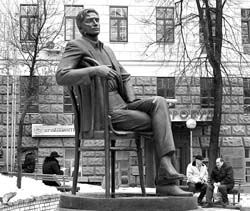New course set to Les Kurbas
120th birth anniversary of the distinguished director, actor, and teacher marked on Feb. 25
The history of Ukrainian culture contains the legendary names that our nation and the European theater elite associate primarily with the reorganization of art. One of these reformers was Oleksandr Stepanovych Kurbas (Les Kurbas), who is respected not only by theater specialists but the Ukrainian public at large.
THE MOLODYI THEATER
From his youth Kurbas cherished the idea of a national democratic theater that would combine the finest traditions of classical Ukrainian art, a high standard of performance introduced by giants of the theater, and his own quest for forms and methods for conveying characters, emotions, and feelings on the stage. That was why Kurbas first joined Mykola Sadovsky’s theater and then exchanged his actor’s career for that of director. As a stage director he channeled all his creative energies into creating a young actor’s studio that eventually became the Molodyi Theater.
The newly established drama company rented the Bergonier Theater, located today on Prorizna Street in Kyiv. Not all patrons of the Molodyi Theater, under the able guidance of Stanislav Moiseiev, know that its name is legendary: it was once the name of a small drama company determined to make the world accept the Ukrainian theater in the universal art context.
The Molodyi Theater began by staging Volodymyr Vynnychenko’s play Chorna Pantera, Bilyi Vedmid (The Black Panther and the White Bear). This choice was already an indication of the experimental nature of the newly established theater, because what appeared on stage was contemporary national dramaturgy presenting individual problems through the eyes of a cosmopolitan individual. Subsequent productions included Hrikh (The Sin), The Bazaar, Haidamaky, and other works.
It was as though a theatrical avant-garde had exploded in Ukrainian culture, which inclined to the semantic and role-based polysemanticity on stage and the symbolic nature of theatrical art. Kurbas introduced into the Ukrainian national theater the actor’s system of artifice, which takes on carnival and clownery elements and requires a high level of technical preparation and the ability to use non-verbal means of communication.
PHILOSOPHICAL THEATER
After the prominent Ukrainian director founded the Berezil Theater, modern national theatrical art changed course from the political to the philosophical. Kurbas then launched an artistic struggle against the vulgarization of theater, the simplification of the repertoire, and the “adaptation” of performances to the occasionally undemanding tastes of certain social strata.
Not all spectators could appreciate Berezil’s resonant stage productions because understanding them required a certain educational level, and mental and spiritual preparation. Yet Kurbas never capitulated but continued to move forward boldly, introducing his innovative directorial ideas.
The Berezil Theater found its playwright, and its collaboration with him marks a separate page in the history of this drama company. His name was Mykola Kulish whose plays The People’s Malakhii, Myna Mazailo, and Maklena Grasa were staged by Kurbas’s theater. Berezil also had a music hall and a directors’ laboratory that served as a creative and educational institution for its actors. Here they engaged in creative research and uncovered dramatic and spiritual truths.
Kurbas delved into the world classics, and on his stage appeared the “Costumed Stories” series (Zhakeria, The King Is Playing, and other plays), as well as productions of Shakespeare’s works. Each of these scenic creations gained new semantic shadings and was permeated with coded signs of multiple meanings that had to be explained to the audience.
THEATER OF QUESTS
The creative quests and experiments of Kurbas’s theater are perceived in the general cultural context. The improvisational nature of his theatrical art evokes associations with the first professional theater of the Renaissance era, the Commedia dell’arte (theater of masks); the effect of estrangement, with Bertolt Brecht’s epic theater and its non-Aristotelian devices of influencing the spectators’ consciousness; a certain puppet-like, symbolic, and philosophical nature, and high level of the performances’ conventionality, reminiscent of Maurice Maeterlinck’s symbolist theater.
Kurbas also introduced new technical devices, like the use of cinematographic detail, abstract sound design of the action, and the introduction of the symbolic function of crowd scenes.
For Ukraine, Les Kurbas was truly an author of the “new course” in national theatrical culture. His name is unforgettable, which is evidenced by attention paid to his singular talents by contemporary theater specialists and artists, who from time to time attempt to “summon” his assistance and revive his methods, devices, and meanings of his original theater.






